The Flir One thermal camera caused quite a stir when it was launched back in 2014. Both the Flir One and its prime competitor Seek Thermal represented the first “cheap” thermal cameras available to the public. At the heart of the Flir One was the Lepton module, which could be purchased directly from Flir Systems, but only in quantity. [Mike Harrison] jumped on board early, cutting into his Flir One and reverse engineering the Lepton module within, including the SPI data required to talk to it. He even managed to create the world’s smallest thermal imager using a the TFT screen from an Ipod Nano.
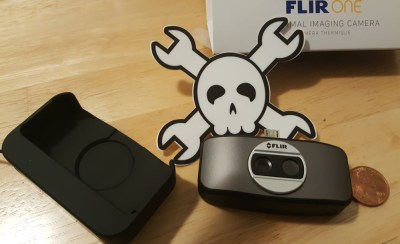 A few things have changed since then. You can buy Lepton modules in single quantity at DigiKey now. Flir also introduced a second generation of the Flir One. This device contains an updated version of the Lepton. The new version has a resolution of 160 x 120 pixels, doubled from the original module. There are two flavors: The iOS version with a lightning port, and an Android version with a micro USB connector. I’m an Android user myself, so this review focuses on the Android edition.
A few things have changed since then. You can buy Lepton modules in single quantity at DigiKey now. Flir also introduced a second generation of the Flir One. This device contains an updated version of the Lepton. The new version has a resolution of 160 x 120 pixels, doubled from the original module. There are two flavors: The iOS version with a lightning port, and an Android version with a micro USB connector. I’m an Android user myself, so this review focuses on the Android edition.
The module itself is smaller than I expected. It comes with a snap-on case and a lanyard. While you’ll look a bit like a dork wearing the lanyard, it does come in handy to keep the imager from getting lost or dropped. The Flir One has an internal battery, which of course needs to be topped off before it can be used. Mine charged up in about half an hour.
The Flir One’s micro USB connector is extra long, which is perfect for people who keep their phones in a skin case. I had no problem using it with my Note 5 in a case. They also include a couple of self-adhesive rubber spacer pads to ensure a good fit between the module and your phone.
Using the Flir One
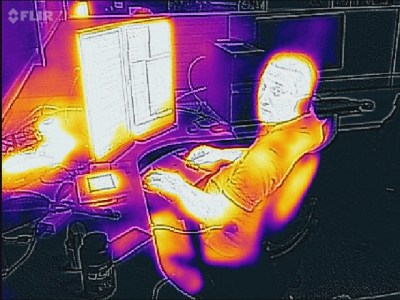 The main software interface for Flir One is Flir’s own app from Google Play. The software will automatically launch when the camera is connected and powered up. Don’t expect high frame rates from this camera. The Lepton runs at 8.9 fps. While you won’t be shooting feature films with it, this is plenty fast enough for thermal analysis. The camera will appear to freeze for a moment every 30 seconds or so. This is caused by the Flir One closing the Lepton’s mechanical shutter and acquiring a dark frame. Much like long exposure photographs taken with a conventional DSLR, this dark frame allows the Flir One to calibrate against a known dark image.
The main software interface for Flir One is Flir’s own app from Google Play. The software will automatically launch when the camera is connected and powered up. Don’t expect high frame rates from this camera. The Lepton runs at 8.9 fps. While you won’t be shooting feature films with it, this is plenty fast enough for thermal analysis. The camera will appear to freeze for a moment every 30 seconds or so. This is caused by the Flir One closing the Lepton’s mechanical shutter and acquiring a dark frame. Much like long exposure photographs taken with a conventional DSLR, this dark frame allows the Flir One to calibrate against a known dark image.
The Flir One can measure temperatures within the range of -4°F to 248°F (-20° to 120°C), so unfortunately you won’t be able to measure your soldering iron temperature with it. Testing against the hot exhaust of my car, the temperature spot display simply displayed “> 248”
Flir includes the ability to snap photos from their software, as well as videos, time lapse videos, and panoramas. Yes, you can even share your thermographs on Twitter and Instagram. Videos use the phone’s microphone to record audio.
Using the Flir One, it quickly becomes apparent that the images look higher than 160×120. This is because the Flir One has two cameras – the Lepton module and a 640 x 480 visible light camera. The Flir One software overlays the two images. They call this Multi Spectral Imaging (MSX). Most of the time, MSX is handy. Sometimes it does get in the way though, especially with macro images. Two cameras will always have some parallax error. When filming objects close to the Flir One, the parallax becomes apparent as the thermograph colors are offset from the visible image outlines. Flir’s solution to this is Macro mode, which allows the user to align the two images with a slider. This can be a bit fiddly, especially when filming closeup objects with unsteady hands. A fixture to hold the phone over the work comes in very handy.
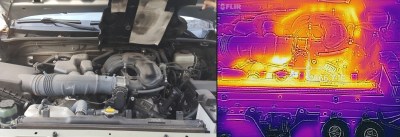
MSX can also be annoying if you just want to view the thermal image. Previous versions of the Flir One software allowed the visible camera to be disabled. Unfortunately, that option is gone. Cutting out the visible light camera can still be done manually with a piece of tape or a finger, but Flir One’s software shows its displeasure by cranking the gain on the visible camera, filling the final image with noise.
Impressions
Seriously, even with the shortcomings mentioned above, thermal cameras are fun. I’ve had the camera for almost a week now, and the “cool new gadget effect” hasn’t warn off. I still find myself popping it onto the phone to get a thermal view of the world around me. Pointing the Flir One at the walls and ceiling of a room can reveal anything from heating ducts in the walls, to electrical problems, to cool spots created by moisture from hidden leaks.
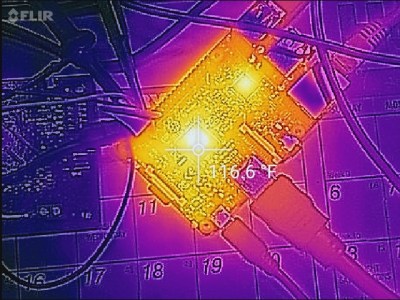 On the electronics side, the Flir One has already been a huge help. I was able to capture images of a Raspberry Pi 3, with its processor running around 116.6 °F (47 °C). Turning the camera on one of my own designs, I found a couple of power supply capacitors running a bit hotter than I’d like.
On the electronics side, the Flir One has already been a huge help. I was able to capture images of a Raspberry Pi 3, with its processor running around 116.6 °F (47 °C). Turning the camera on one of my own designs, I found a couple of power supply capacitors running a bit hotter than I’d like.
The Flir even showed me a potential issue with the 60 year old electrical system in my home. Check out this image of my circuit breaker panel. The hotspot on the lower left is the circuit breaker for the electric water heater, which was working hard since someone in the house had just taken a hot shower. The image alarmed me at first, but touching the breaker and the wire itself they barely even seemed warm. It turns out I was seeing an effect of temperature span.
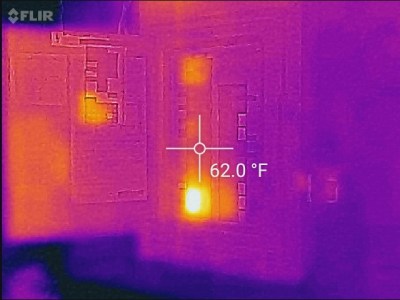 The Flir One software constantly tries to adjust for maximum scene contrast based upon temperature. If the image being viewed only has a couple of degrees span between the hottest and coldest elements, then those items will be colored as such.
The Flir One software constantly tries to adjust for maximum scene contrast based upon temperature. If the image being viewed only has a couple of degrees span between the hottest and coldest elements, then those items will be colored as such.
The span in that image was two only a couple of degrees, with the breaker being the hottest element of the image. Flir’s software colored things appropriately. Good thing I checked the breaker by touching it before busting out the fire extinguisher!
One word of warning: some people think thermal camera means “Sees through clothing”. Much of this goes back to the Sony Nightshot mods of the late 1990s. Cameras modded with filters were able to image through clothing. The Flir One will see body heat, and it can image through anything that is transparent to infrared, such as plastic shopping bags. While I didn’t run into any cases of see-through clothing, the Flir One will see body heat. Not everyone is comfortable with that, which is something to keep in mind if you bring your thermal camera out and about.
Hack it!
This wouldn’t be a Hackaday review if we didn’t give you some information on hacking with the Flir One. Flir themselves have released an Android SDK on their developer portal. The company also sponsored a number of thermal powered Hackathons in late 2015.
On the internals side, [James Peverill] posted a thorough teardown of the Flir One, showing the Lepton and the Atmel AT91SAM9X25 microcontroller which powers it.
Plugging the Flir One into a PC requires a micro USB female to USB type A male cable. This isn’t exactly a standard cable. After getting my hands on one, I plugged the Flir One into a desktop PC. It enumerates as VID: 09cb, PID: 1996. Of course, Linux didn’t have a driver for it, however the folks over on the EEVblog forum are still working on that.
The Bottom Line
The Flir One sells for $250 USD. While that is a heck of a lot cheaper that just about any other thermal camera, it’s still a decent chunk of change. Is this a must have tool? No. It’s one of those tools which can be a huge time saver when you need it. I could definitely see a hackerspace buying one for members to use.
Author’s Note: I purchased the Flir One module in this review for my own use. Flir Systems was not involved in the purchasing or the review process.
















This app allows you to turn off the visible camera.
https://play.google.com/store/apps/details?id=georg.com.flironetest_01
That’s pretty darn cool – glad people are able to do this with the SDK.
I’ve had a FLIR camera for a few years now and it’s fundamentally changed the way I do PCB bring-up and debug. It’s far more than just “hey, that thing shouldn’t be hot”, the thermal resolution is such that even dissipation of a few tens of milliwatts can be seen sometimes. What was once an hour-long debug process is now a 30-second exercise in finding the heat bloom.
One thing to watch out for: read up on emissivity. IR emission can vary wildly across different materials and surface finishes. Don’t rely on IR for critical temperature measurements, always use a contact measurement of some sort.
Best PCB debugging tool around. Reflectivity is also something important to watch out for. HASL pads, glass, and flat Al surfaces are quite reflective to LWIR so you’ll often find the hotspot on your board is a reflection of your face.
Yea, or a light, or another heat source reflecting. I love mine , but that is the only drawback, false readings from reflections on surfaces specular in the IR. I can see the thermal image of myself reflected in a sheet of aluminum that has been painted flat white. No reflection whatsoever in the visible spectrum ( just diffuse white), but in the IR, its like a darn near perfect mirror.
This app allows you to turn off the visible camera!
https://play.google.com/store/apps/details?id=georg.com.flironetest_01
Btw, has anyone managed to bypass that low rate fps limit on the thermal imager? Does anyone know if this is hardware or artificially imposed limitation?
I have a Flir Lepton module running off a Pi, and to me it seems like it’s faster. Not 30 fps, but more than 9 fps.
The Lepton is ‘fun’ but it really does need the thermal background compensation. At the time I’d ordered mine, the shutter assembly wasn’t available. The lack of sensor uniformity throws off the automatic scaling such that small thermal differences can be hard to see.
I personally would not choose the bare lepton sensor if I could not also get the shutter. I think you’re better off buying the FlirOne instead.
Supposedly artificial, to meet export regulations. IIRC, on the old Lepton module, someone bypassed it by overclocking the whole thing. Got up to about 15FPS, without much more noise.
I’m betting that’s an ITAR limit – but don’t know enough about microbolometer acquisition times to say for sure.
Indeed an ITAR limit, but even if you could get an unlocked 50Hz version the small lens would likely mean that you would have to combine several frames to get a good picture.
What would the aimed goal exactly be for such a limitation?
Russians using this for insulating weapons factories more? And why does 15 fps vs 9 fps matter?
I don’t get it :)
It makes it much harder to use it on something like a rifle scope or DIY heat seeking missile. I have uncooled 320×240 and 640×480 and cooled 640×480 cameras that do 30fps and the difference is quite noticeable in just handling.
The 9fps limit isn’t arbitrary, it’s about preventing people from making feasible heat-seeking weapons. The exact reasoning is actually classified. There’s a poster on one of the flir hacking forums who was involved in thermal systems for the US military, and that’s as much as he was legally able to say about it.
http://murdercube.com/files/Rocketry/Missiles%20and%20Warheads/Missile%20Guidance%20&%20Control%20Systems.pdf
Look at page 142 to see exactly where this would fit in
Adam
Google didn’t turn up anything on a ” miceobolometer ”
Is there another type of rodent I should try?
B^)
Edited my comment to fix the typo (Damn it’s nice to have that edit button :)
https://en.wikipedia.org/wiki/Microbolometer
Sparkfun also cares the Lepton module, along with a tutorial.
Whoops – should have included them – sparkfun rocks!
https://www.sparkfun.com/products/13233
If you dont care about the accuracy of the number shown by the temp cross hair you can turn off the auto adjust feature which prevents the need for the module to freeze every 30 seconds
i was actually eyeballing the FLIR one a few days ago, but needed to do some more research and comparisons.
Great article ! I’ll be ordering one for sure.
So how far can this thing see thermal. Lets say I’m deer hunting at dark and I shoot a buck, he’s hit but bolts and comes down maybe a mile away. Generally I track him in the dark until I find him, but this takes time and skill, and can be dangerous. Curious if I could use this with my phone to follow the blood trail left or see the deer from a few hundred feet.
The IR it is seeing is just fancy light, so it should be able to register the deer as a hotspot as long as it was alive and in its visual field. It would help if it was an otherwise cool night.
blood going to cool pretty much stright away. Not sure about range but police helicopter ones seem to have pretty good range
You’d be surprised how long a heat footprint lasts
Depends on the temperature of the surrounding area, and how hot the buck is. Past 100 feet or so, most sources are going to blend into the background noise. That’s mostly due to the lens on the Flir One. Just like optical cameras, thermal cameras have telephoto lenses.
The range where you can identify a person is about 50 meters.
Quit terrifying animals and especially if you are a poor shot!
I’m using the linux driver that I helped develop to use the Flir One G2 in a UAV application.
Very much a work in progress.
http://www.3drpilots.com/threads/solo-development-area.5062/
Bought one in december 2015. It is really a cool gadget, but really picky about OTG. Top gamma Samsung work best, then i found it works nicely also on the 4.5 aquaris from BQ, which is the cheapest i could find that works. And even having top phones won’t guarantee it will work -.-
By using it i suggest to always make photos with the pointer, later can be dragged to see other temperatures, while if you don’t use it, it can’t be added later.
It is awesome also for clothing. Wearing IR reflectant on the inside and black on the outside really makes a greenhouse effect. And the cheapest material that does it are easter eggs packaging.
And if anyone is looking for a professional version for their lab, we just picked up a Flir TIX500. The extra resolution really helps in identifying specific components on a small PCB that are heating up.
http://amzn.to/1Wf0L5M
Sometimes Tequipment has a better price.
http://www.tequipment.net/Fluke/TIX500-60HZ/Building-and-Industrial-Thermal-Imagers/?v=0
Bought the 1st gen Flir One for iPhone earlier this year. It comes with a protective phone case which slides to the imaging unit, like piggybacking on the phone. It makes the 5S twice as thick, but I like chunky phones which won’t slide off my hands easily so I’ve been carrying it. Been checking window insulations, possible heat issues in small wiring closets and servers, heating panels on a ceiling, air conditioning… and on the first day just running cold water to a sink, then suddenly turned on hot water (or vice versa) and enjoyed the view. Haven’t tried to find people/animals in the dark yet (don’t stalk!), but some say it sees within a limited distance; barely sees after 300 feet in good weather.
I’d say it really is worth the £150. 1st gen camera has lower resolution than this 2nd gen camera, also calibration is manual by pulling a slider down occasionally, but it’s good enough for me.
Fun fact: The MSX jpgs that the flir one app creates actually still contain the thermal image and the visible image packed in them.
To extract them, use exiftool (https://sourceforge.net/projects/exiftool/):
exiftool.exe -b -rawthermalimage test.jpg >rawthermalimage.png
exiftool.exe -b -embeddedimage test.jpg >embeddedimage.png
The raw thermal image is a 16bit png, which still has to be converted to temperature using some other values in the exif data. This page has some info and a shell script that reads and converts: http://130.15.24.88/exiftool/forum/index.php?topic=4898.60
Also be careful when sharing the images online as they contain GPS coordinates.
Has anyone seen how well this module perform when taking images of objects that are far away ? Say 100m to 300m. I was wondering if it would detect animals at that range, especially in daytime.
I would like to know this too, could be great for an airsoft turret.
No. Too low resolution, at that distance you wouldn’t recognize between a car and a truck.
FWIW the Sony perv-cam used IR much closer to visible light. This is more “thermal” IR, I don’t know if it’s even physically possible to see anything worth seeing, perv-wise, at such a wavelength.
Anyone knows if it’s possible to use android version with iphone with adapter? I did try with one adapter and it did not work.. Also seems that it’s a bit tricky to find adapter for usb type c that works.
Has anyone used it for night hunting,e.g. Foxes rabbits etc. And what is the range. distance ?.
how to change the flir one second generation battery,pleased,tq
Flir App update (Android, but according to Amazon review it’s the same for iOS) now nags you with (mandatory?) registration. Also, my device used to work but now is not recognized at all :-(
That’s good to know. I recommend you find an older apk for the app and see if that fixes your trouble.
Has anyone written a flir one G2 driver for linux yet? and is it available
I believe the flir one is a good entry level thermal camera, but I think Seek is better because of higher resolution. Check the video on this site. In total darkness, Seek is way better https://thermalimagingcamerareviews.com/best-budget-thermal-cameras/
Can anyone tell me if the flir one for iOS fills in android with a USB adapter? I have a flir where for iOS but I want to use it in an android now and I am sad because with the adapter did not work … will someone know me explain why? Is the communication different?
Yes it can however, there is something you need to do on the inside, I don’t remember how but it is possible. Also a way to bypass in order to allow your phone and the device to charge at the same time.